
By Adam Scott, MS, CSCS
For a previous Mini-Study, we had our athletes complete a simple snapshot study using trekking poles around a standard 1/4 mile track.
This time, we stepped things up a little (literally) and loaded our athletes with approximately 40% of their body weight (between 50-75 lbs). Then we took them to the slopes.
The research we found on this matter was split on the effect of trekking poles. The two uphill studies we reviewed showed that trekking poles decreased lower body (LB) joint stress and increased stride length. However, the studies were split on whether trekking poles improved efficiency (2,4).
SNAPSHOT #1: UPHILL, LOADED MOVEMENT
Subjects and Design:
Six athletes completed two hiking trials on consecutive days. Each athlete was randomly assigned to one of two groups. Group 1 acted as the control group and completed both trials without poles. Group 2 hiked the first day without poles and the second day with poles. The group average demographics are contained in TABLE 2.
TABLE 1: Average Group Demographics

Study Trials:
Both trials were completed on Snow King Mountain in Jackson, WY. The hiking path was a 1000m (.62 mile) stretch of the mountain’s boot pack trail. The path covered approximately 3281ft of horizontal distance and 1556ft of vertical distance, giving the route an average grade of 47.4% (27.1 degrees).
FIGURE 1: Hiking Route (via google Maps)
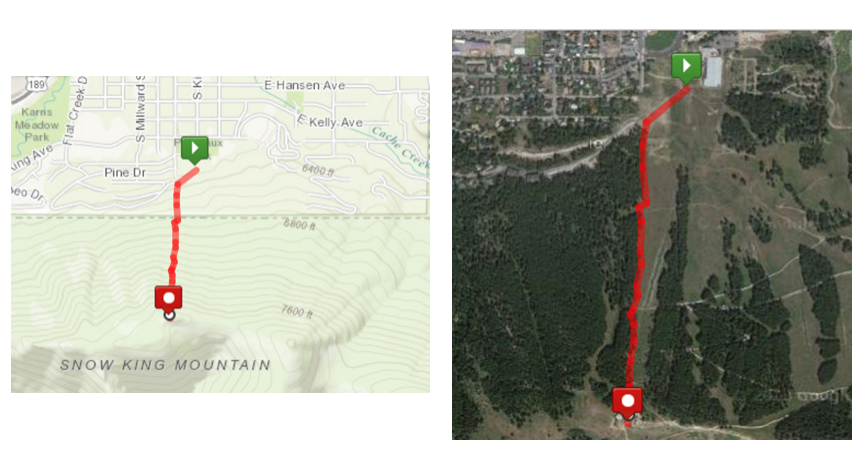
All six athletes were required to maintain the same, self-selected pace during both trials. Speed, distance, elevation, HR and breathing rate (BR) were collected using our Zephyr Bioharnesses and paired GPS trackers. At the conclusion of each trial athletes were asked to rate their exertion on a scale of 1-10 (Rate of Perceived Exertion – RPE).
Trial one established a non-pole baseline for our athletes. For the second trial athletes were randomly divided into two groups of three athletes.
Group 1 acted as the control group, and again hiked without poles. Group 2 served as the treatment group and was allowed to use trekking poles during the second trial. Thus, to determine the effect we compared the two groups during trial one and trial two.
TABLE 2: Trial 1 versus Trial 2
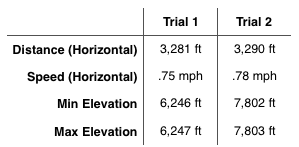
Results and Discussion:
Our results show that trekking poles seem to have a positive effect on uphill efficiency. And, although, using paired T-Tests, our results did not meet the threshold for statistical significance, based on our snapshot we believe that, given a larger sample size the effects would have been significant.
TABLE 4 contains the per-trial data for each group. As you can see both groups experienced slight decreases HR and BR from trial 1 to trial 2.
TABLE 3: Group Results from Trial 1 and Trial 2
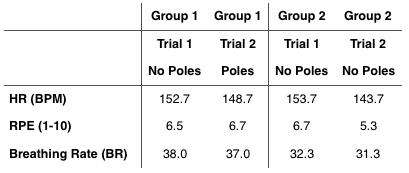
However, looking at the group RPEs we find our first major difference. The non-pole group actually found trial 2 to be slightly harder than trial 1 (2.6%). On the contrary, the trekking pole group reported that trail 2 was about 20% easier than trial 1. These changes can be seen in GRAPH 1.
GRAPH 1: Percent Changes from Trial 1 to Trial 2 (Positive % = Improved Measure)
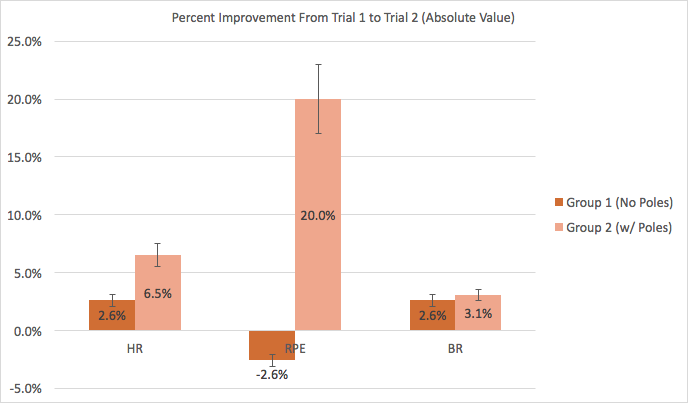
To assess overall metabolic efficiency we once again turned to the connection between HR and speed called: Heart Rate-Running Speed Index (8-9). This index is based on the finding that HR and running speed have a linear relationship. If trekking poles do improve efficiency, the effects should be seen as increases in the group’s Heart Rate-Running Speed Index.
As you can see in GRAPH 2, the trekking pole group experienced a 16.0% increase in efficiency (based on their HR-Running Speed Index) while the non-pole group experienced only a 5.0% increase. The means that the trekking pole group gained about 11.0% more efficiency.
GRAPH 2: Trial 1 and Trial 2 Running Efficiency Scores
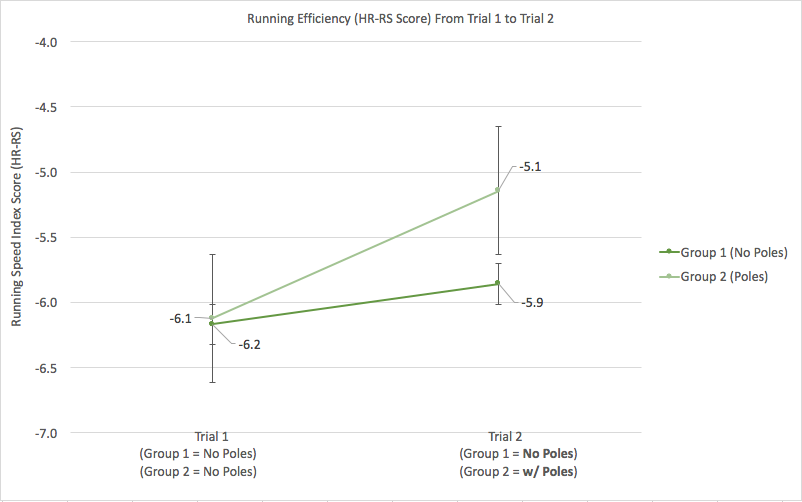
SNAPSHOT #2 OUTCOME
Our real-world results add weight to the laboratory studies which show that trekking poles can have a positive effect on uphill movement. Perrey, et al. (2007) and Knight, et al. (2000) found that trekking poles significantly decreased lower body joint stress. Our snapshot study seems to point to trekking poles also having a positive effect on efficiency.
When hiking uphill at significant grade, under significant load (approximately 47% grade and 40% bodyweight) trekking poles increase efficiency by approximately 10% and decrease perceived effort by 20%.
SNAPSHOT SHORTCOMINGS
- Small, Homogenous Sample Size: With six athletes (3 per group) finding statistical significance is difficult. Our paired T-Test analysis returned a p-value (significance) of approximately .68, well outside of the standard .05.
- Environmental Conditions: As you can see in the picture above, our athlete’s were hiking in the snow. Although the boot pack trail was fairly well established this undoubtedly affected our athlete’s footing during the trials. The boot pack also acted as a control for the athlete’s stride length. It is possible that results could have differed under the different footing.
- Load: The athlete’s load was distributed along their entire body. Athletes were required to add an additional 20-25 lbs to their pack, but the remainder of the weight (25-45 lbs) was made up of the athlete’s gear and clothing, which was not regulated.
- Speed: Speed was not controlled, athletes were required to hike together at a self-selected pace. Although the speed during each trial was fairly slow (.75 and .78 mph) the trials were actually quite stressful. Trial 1 was completed at 83% and 88% max HR (Group 1 and Group 2, respectively) and Trial 2 was completed at 81% HR max for both groups.
References:
- McNamara, C and Neale, M. Ten reasons for trekking poles. Outdoor gear lab. Published: 29 JUL 2014. http://www.outdoorgearlab.com/a/11089/Ten-Reasons-for-Trekking-Poles. Accessed: 17 FEB 2016.
- Perrey, S. and Fabre, N. Exertion during uphill, level and downhill walking with and without hiking poles. J of Sport Sci and Med; 7: 32-38. 2007.
- Porcan, J, Hendrick, T, Walter, P, Terry, L and Walsko, G. The physiological response to walking with and without power poles on treadmill exercise. Res Quarterly for Ex and Sci; 68(2): 161-166. 1997.
- Knight, C and Caldwell, G. Muscular and metabolic costs of uphill backpacking: are hiking poles beneficial? Med & Sci in Sport & Ex. FEB 2000.
- Wilson, J, Torry, M, Decker, M, Kernozek, T and Steadman, J. Effects of walking poles on lower extremity gait mechanics.Med & Sci in Sport & Ex. MAR 2000.
- Schwameder, H and Muller, E. Comparisons of knee joint forces during downhill walking with and without hiking poles. J of Sport Sciences; 17: 969-978. 1999.
- Hutchinson, A. Tracking FItness with the “Heart Rate-Running Speed Index.” Runner’s World. www.runnersworld.com. Accessed: 17 FEB 2016.
- Vesternin, V, Hooka, L, Hynynen, E, Mikkola, J, Hakkinen, K and Nummela, A. J of Strength Cond Res; 28(4): 902-908. 2014.